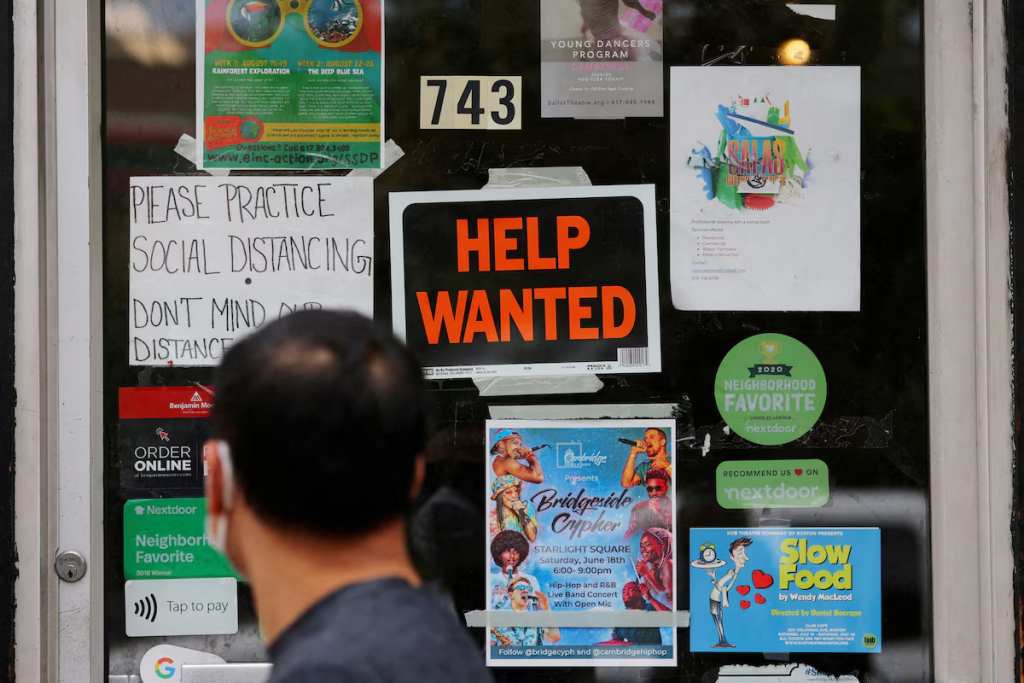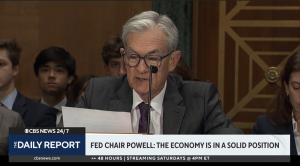The number of Americans filing new applications for jobless benefits fell last week, but work opportunities are becoming scarce as businesses remain hesitant to hire because of an uncertain economic outlook, raising the risk of the unemployment rate increasing in June.

The weekly jobless claims report from the Labor Department on Thursday, the most timely data on the economy’s health, also showed state unemployment benefit rolls in mid-June increasing to the highest level in 3-1/2 years. Though layoffs remain historically low, hiring has been tepid, with economists saying President Donald Trump’s broad import tariffs are making it difficult for businesses to plan ahead.
But the labor market slowdown was not yet alarming enough for the Federal Reserve to resume cutting interest rates in July, they said. Fed Chair Jerome Powell told lawmakers this week the U.S. central bank needed more time to gauge if tariffs raised inflation before considering lowering rates.
“The data are consistent with softening of labor market conditions, particularly on the hiring side of the labor market equation,” said Nancy Vanden Houten, lead economist at Oxford Economics. “For now, we don’t think the labor market is weak enough to prompt the Fed to cut rates before December, but the risk is increasing that once the Fed starts to lower rates, it will have some catching up to do.”
Initial claims for state unemployment benefits dropped 10,000 to a seasonally adjusted 236,000 for the week ended June 21, the Labor Department said. Economists polled by Reuters had forecast 245,000 claims for the latest week.
The data included last week’s Juneteenth National Independence Day holiday, which likely injected a downward bias.
Cutting through the technical distortions, layoffs have picked up amid headwinds from the import duties.
The number of people receiving benefits after an initial week of aid, a proxy for hiring, jumped 37,000 to a seasonally adjusted 1.974 million during the week ending June 14, the highest level since November 2021, the claims report showed.
The so-called continuing claims covered the week during which the government surveyed households for June’s unemployment rate. Continuing claims increased between the May and June survey weeks, leading economists to expect that the unemployment rate rose to 4.3% in June from 4.2% in May.
A survey from the Conference Board this week showed the share of consumers who viewed jobs as being “plentiful” dropped to the lowest level in more than four years in June.
“It is likely that the unemployment rate will tick up at least to 4.3% in June, with material risk of it rising to 4.4%,” said Abiel Reinhart, an economist at J.P. Morgan.
June’s employment report is due next week. The U.S. central bank last week left its benchmark overnight interest rate in the 4.25%-4.50% range where it has been since December.
Stocks on Wall Street rose. The dollar hit a 3-1/2-year low against the euro and sterling as traders bet on more rate cuts than currently anticipated. U.S. Treasury yields fell.
GDP REVISED LOWER
The Trump administration’s tariffs are distorting the economic picture and this was reinforced by other data on Thursday.
Gross domestic product decreased at a downwardly revised 0.5% annualized rate in the first quarter, the Commerce Department’s Bureau of Economic Analysis (BEA) said in its third estimate of GDP.
The economy was previously reported to have contracted at a 0.2% pace. It grew at a 2.4% rate in the fourth quarter. A front-running of imports ahead of the sweeping tariffs accounted for the bulk of the decrease in GDP last quarter.
The revision to GDP reflected a sharp downgrade to consumer spending, which is now estimated to have increased at only a 0.5% pace instead of previously reported 1.2% rate. Consumer spending grew at a robust 4.0% pace in the fourth quarter as households engaged in pre-emptive buying of goods like motor vehicles to avoid higher prices from import duties.
The fading boost from frontloading of purchases by consumers meant underlying demand in the economy was not as strong as previously reported. Growth in final sales to private domestic purchasers, closely watched by policymakers, was cut to a 1.9% rate from the previously reported 2.5% pace.
While the flow of imports has since subsided, exports are taking a hit from the trade tensions. A third report from the Census Bureau showed the goods trade deficit widened 11.1% to $96.6 billion in May, with exports dropping $9.7 billion to $179.2 billion. But goods imports were little changed at $275.8 billion, positioning GDP for a sharp rebound this quarter.
The Atlanta Federal Reserve is forecasting GDP accelerating at a 3.4% rate in the second quarter. Given the gyrations from imports, economists cautioned against interpreting the anticipated bounce back in GDP as a sign of economic strength.
Temporary pauses on higher tariffs expire in July and mid-August, and it is unclear what happens next.
Data on retail sales, the housing and labor markets have suggested economic activity is softening.
“The difficulty of accurately capturing the extraordinary foreign-trade and inventory gymnastics that companies undertook to avoid U.S. tariffs created serious measurement challenges that will linger for some time to come,” said Lou Crandall, chief economist at Wrightson ICAP.
Though a fourth report from the Census Bureau showed orders for long-lasting manufactured goods rebounded sharply in May because of strength in the volatile commercial aircraft segment, tariff uncertainty remained a constraint for business spending.
Orders for durable goods, items ranging from toasters to aircraft meant to last three years or more, jumped 16.4%. That was the largest increase since July 2014 and followed a 6.6% decline in April. Commercial aircraft orders soared 230.8%.
Non-defense capital goods orders excluding aircraft, a closely watched proxy for business spending plans, rebounded 1.7% after falling 1.4% in April. Shipments of core capital goods rose 0.5% after being unchanged in the prior month.
“Rebounding orders in May could simply reflect a resumption or normal activity after tariffs were paused,” said Veronica Clark, an economist at Citigroup. “The level of core capital goods orders is flat since the start of the year.”
Reprinted from Reuters

